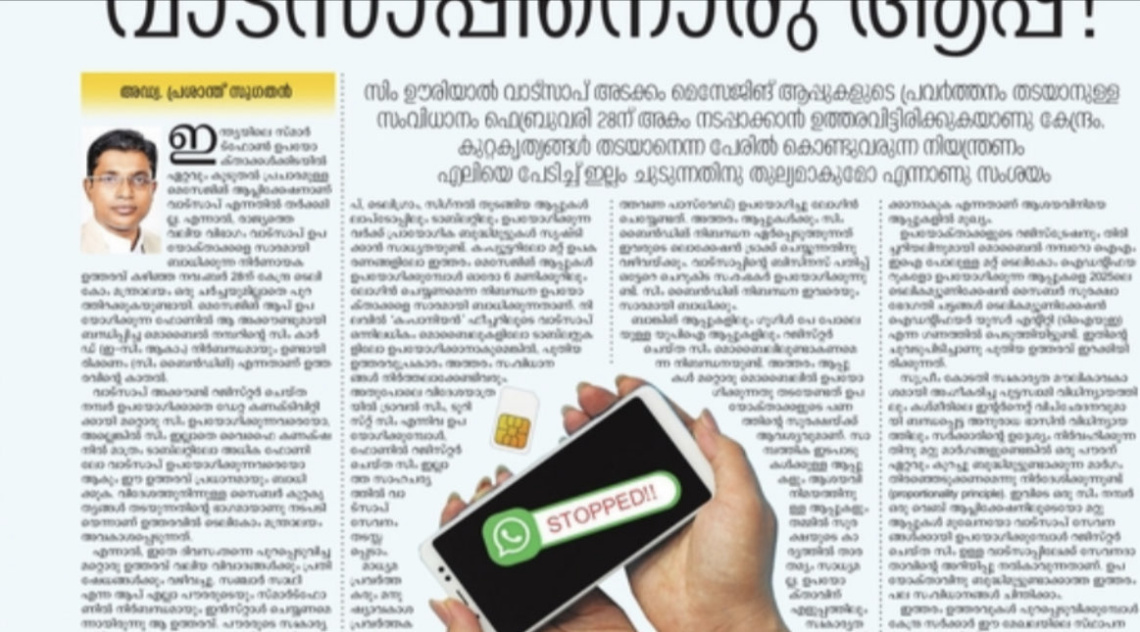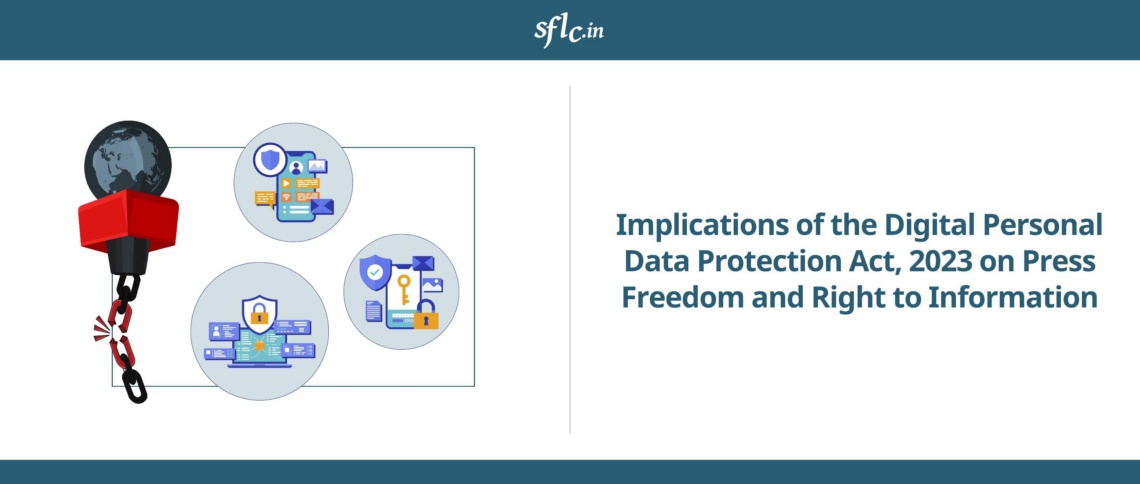 The Aadhaar scheme originated as an operation of the Unique Identification Authority of India that was established in 2009 as an executive body under the Planning Commission. This scheme was meant to ensure better transfer of benefits of Government welfare schemes through a biometric and demographic identity number and card. From its inception, Aadhaar has been under the fire for a number of reasons, including the absence of a governing legislation and concerns surrounding privacy and data protection. The Aadhaar scheme’s lack of statutory foundation was also highlighted by several petitions that challenged its constitutional validity before the Supreme Court. In an apparent effort to remedy this state of affairs, The Aadhaar (Targeted Delivery of Financial and other Subsidies, Benefits & Services) Bill, 2016 was introduced in the Lok Sabha on 3rd March, 2016, with the stated object of providing efficient, transparent and targeted delivery of subsidies, benefits and services.
The Aadhaar scheme originated as an operation of the Unique Identification Authority of India that was established in 2009 as an executive body under the Planning Commission. This scheme was meant to ensure better transfer of benefits of Government welfare schemes through a biometric and demographic identity number and card. From its inception, Aadhaar has been under the fire for a number of reasons, including the absence of a governing legislation and concerns surrounding privacy and data protection. The Aadhaar scheme’s lack of statutory foundation was also highlighted by several petitions that challenged its constitutional validity before the Supreme Court. In an apparent effort to remedy this state of affairs, The Aadhaar (Targeted Delivery of Financial and other Subsidies, Benefits & Services) Bill, 2016 was introduced in the Lok Sabha on 3rd March, 2016, with the stated object of providing efficient, transparent and targeted delivery of subsidies, benefits and services.
In light of the enduring concerns around this Bill relating to privacy and data protection, this blog-post contrasts the provisions of the Bill against the nine National Privacy Principles contained in the “Report of the Group of Experts on Privacy“, headed by Justice A.P. Shah, and published by the Planning Commission of India in 2012. This report served as a comprehensive analysis of India’s constitutional journey of the right to privacy, the global landscape of privacy and data protection legislations. The National Privacy Principles in particular seek to establish safeguards vis-a-vis initiatives dealing in personal information, and rights of data subjects in connection with such information, thereby serving as an excellent frame of reference for any legislation such as the Aadhaar Bill 2016 that raise substantive privacy and data protection concerns. On 11th March, 2016, the Aadhaar Bill was passed by the Lok Sabha as a money bill.
Important Definitions from Aadhaar Bill, 2016
-
Core biometric: Fingerprint, Iris scans or other biological attribute as may be specified (Leaves room for possibility that other biological attribute like DNA can be included in future)
-
Identity information: Aadhaar number, biometric information, and demographic information
-
Biometric Information: Photograph, finger print, Iris scan, or other such biological attribute as may be specified.
-
Authority: Universal Identification Authority of India (UIDAI)
-
Central Identities Data Repository (CIDR): a centralized database in one or more locations containing all Aadhaar numbers issued to Aadhaar holders along with the demographic information and other information.
-
Enrolling Agency (EA): Appointed/contracted for collecting demographic and biometric information for the enrollment into Aadhaar.
-
Requesting Entity (RE): any agency or person that submits the Aadhaar number, and demographic information or biometric information to the Central Repository for authentication.
- Authentication: Verification process of sending biometric and demographic information to the CIDR and CIDR verifies the correctness, or the lack thereof on the basis of the information available with it.
Comparing provisions in Aadhaar Bill with Principles of A.P. Shah Committee Report
A PDF version of the comparison table is available here.
|
Principle in A.P. Shah Report |
Description of Principle |
Corresponding provision in Aadhaar Bill |
Comments/Concerns |
|
|
Enrolling Agency (EA) |
Requesting Entity (RE) |
|||
|
Notice (During collection & Other notices) Both, EAs & REs ‘collect’ information for their specific purposes of enrollment & authentication respectively. |
What information is being collected |
No mention |
Section 8(2)(a): Obtain consent for the purposes of authentication |
No itemized declaration of contents and nature of information being collected is provided to the individual. This is crucial considering the Authority retains the right to include other biological attributes as biometric information through regulations. |
|
Purposes of collecting |
No mention |
Section 8(2)(a): obtain consent for the purposes of authentication |
Proper counseling needs to be given of where Aadhaar can be used, and if alternative measures are also in place. |
|
|
Uses of such information |
Section 3(2)(a): Inform the data subject about the manner in which information shall be used |
Section 8(3)(b): Inform the individual about the uses to which information received during authentication may be put to. |
||
|
Security safeguard established by Data Controller |
No mention |
No mention |
No notice of the security standards followed at the CIDR, or the measures used by the EA & RE to safeguard the data |
|
|
Ability of Data subjects to access & correct information |
Partially. Section 3(2)(c) only provides a notice for the means to access their information. |
N/A (information given at enrollment) |
Correction of information and its procedure is provided under Section 31. But, no notice is given regarding such information at the time of enrollment. |
|
|
Contact details of privacy officers & ombudsmen to file complaints. |
No mention |
No mention |
There is no mention of a complaint mechanism against the EA& RE, or any medium to approach in case of misuse/breach of data held by the Authority. It is clearly stated that the court can only take cognizance when the complaint is filed by the Authority. |
|
|
Notification of data breaches to data subject and commissioner |
No mention |
No mention |
Data subject should be aware for the sake of his safety and securing other social and economic connections linked with his Aadhaar number. |
|
|
Notification to data subject of any legal access to their information |
No mention |
No mention |
Highlights the need for a privacy legislation that lays down the groundwork for accountability of the Government and its agencies as well as enumerates the privacy rights of citizens. |
|
|
Notification of changes in Data controller’s privacy policy |
No mention |
No mention |
Linking/using of Aadhaar is not limited to solely the welfare schemes. Section 57 allows other body corporate or person to use the Aadhaar number for the purposes of establishing identity of an individual after following provisions in Section 8 (Procedure for authentication by requesting entity), and Chapter VI (Security & Protection of Data) of the Bill. It is important that changes in the privacy policies of such body corporates/ anybody else also be notified. |
|
|
Any other information deemed necessary |
Section 3(2)(b): Nature of recipients with whom the information is intended to be shared during authentication |
N/A |
||
|
Choice & Consent |
Choice to Opt in/Opt out of providing PI |
Not mandatory to get an Aadhaar, but under Section 7, the State/Central Government is allowed to make Aadhaar a condition for availing benefits of welfare schemes. |
Effectively, if one wants to avail those benefits that have a mandatory Aadhaar requirement, there is no choice to opt in/opt out. |
|
|
Consent only after providing information practices |
EA: Section 3(2) provides the information practices for an enrolling agency. |
RE: Section 8(3) states Provisions where RE informs the individual about purposes and use of the data |
||
|
After consent has been taken will the data controller collect, process, use, or disclose such information to third parties, except in case of authorized agencies |
Section 8(2)(a): Take consent of individual before collecting his identity information for the purposes of authentication. |
|||
|
An option to withdraw his/her consent given to the data controller |
No mention |
There should be an option to have the information deleted from the CIDR respecting a person’s right to choice, and that Aadhaar is an entitlement and not a compulsion. |
||
|
Information collected on a mandatory basis should be anonymized, if published in public databases |
Section 29(4): No Aadhaar number, or information collected under this number shall be disclosed, published publicly. |
|||
|
Collection Limitation |
Only collect PI from data subjects as is necessary for the purposes identified for such collection, regarding which notice has been provided and consent of the individual taken |
N/A |
Aadhaar is only valid with all the components of the Personal Information that include, photograph, demographic information, fingerprints, iris scans, or other biological attributes as may be specified.
|
|
|
Purpose Limitation |
PI collected should be adequate and relevant to the purposes for which they are processed |
The caption of the bill provides an insight into its purpose states that it for ‘efficient, transparent, and targeted delivery of subsidies, benefits and services, the expenditure for which is incurred from the Consolidated Fund of India…’ |
Contrary to the said purpose, as per Section 57, Aadhaar can be used to establish identity of a person by State or any body corporate or person, by following the obligations in Section 8 (procedures for authentication by Requesting Entity) and Chapter VI (protection & sharing of data). Therefore, the bill is not limiting itself to the delivery of benefits, for which expenditure is incurred from Consolidated Fund of India. |
|
|
Data controller shall collect, process, disclose, make available, or otherwise use PI only for the purposes stated in the notice after taking consent. If there is a change in purpose, must notify the data subject. |
Section 8(2)(b): Requesting Entity ensures information is used only for the purposes of authentication Section 29(1)(b): Core biometrics only to be for the purpose of generation of Aadhaar numbers and authentication under this Act Section 29(3) (a): Identity information with Requesting entity only to be used for the purpose specified to the individual at the time of submitting his information for authentication Section 29(3)(b): Requesting entity shall not disclose Identity information further without prior consent of the individual
|
|||
|
After PI has been used in accordance with the identified purpose, it should be destroyed as per the identified procedures |
No mention |
-PI stored for perpetuity -No mention if any data is retained by RE & EA or if it gets transferred directly to the CIDR servers. -Section 32(1) provides that UIDAI will keep a record of all authentication records, but does not specify retention time of these records. It is important to note that such records make it easy for tracking activities of the person concerned, and with no notification given to the data subject of when their information was accessed by law enforcement, this would be an easy means of surveillance by the Government. It has also been mentioned that this would be a violation against the right guaranteed in Article 20(3). This article includes the right against compulsory extraction of information from a person. Having enough information to profile and track a person would be a serious infringement of this right. (Usha Ramanathan’s comment on P22 of the Standing Committee’s Report) |
||
|
Data retention mandates by Government should be in compliance with the National Privacy Principles |
N/A |
Not in compliance with the National Privacy Principles No option for deletion of data even at the choice of the data subject, personal data as well as the authentication record do not specify time limit for retention |
||
|
Access & Correction |
Data subject shall have access, be able to seek correction, amendments, or deletion of such information where it is inaccurate |
Section 28(5) proviso: Data subjects can request access to identity information, but not core biometrics Section 32(2): Data subject entitled to obtain authentication record in such manner as specified in Regulations. Section 6: Authority may require the data subject to update their demographic and biometric information as may be specified in further regulations. Section 31(2): In case any biometric info is lost or changes, the data subject should ask the authority to make necessary alterations
|
In Section 31(2), there is an option to update the biometric information if it has ‘changed’. This is an acceptance of a possibility that biometric information is vulnerable to change and hence not an infallible identity proof as has been claimed in the Supreme Court by many. |
|
|
Be able to confirm that a data controller holds or is processing information about them |
Section 32(2): Data subject entitled to obtain authentication record in such manner as specified in Regulations. |
|||
|
Be able to obtain from the data controller a copy of the personal data |
Partially. As per Section 28(5), cannot get a copy of their core biometrics. i.e. fingerprints, iris scans, any other biological attribute as may be specified. |
|||
|
Access and correction to any PI may not be given by the Data controller if it is not possible to do so without affecting the privacy rights of another person, unless the person has explicitly consented to disclosure. |
No mention |
This principle is not possible without initially demarcating what are the privacy rights granted to a person by the Indian legislature |
||
|
Disclosure of Information |
Data controller shall not disclose PI to third parties, except after providing notice and seeking informed consent from the individual for such disclosure |
Section 29(1) (a): No sharing of core biometrics Section 29(2): Identity information shared as per the rules provided Section 29(3)(b): Requesting entity shall not disclose Identity information further without prior consent of the individual |
Clarification required on sharing of data amongst government departments, and sharing of data between third parties, not government departments. |
|
|
Third parties are bound to adhere to relevant and applicable privacy principles |
Section 28(4)(c): the Authority shall ensure that arrangements entered into with any third parties enforce equivalent security obligations on data protection. |
|||
|
Disclosure for law enforcement purposes must be in accordance with the laws in force |
Section 33(1): By way of order of nothing lower than a District Judge, identity information or authentication records can be disclosed. This does not apply to core biometric information. Section 33(2): Any disclosure of information , including core biometrics can be done in the interest of National Security in pursuance of a direction of an officer not below the rank of Join Secretary to the Government of India, specially authorised in this behalf by an order of the Central Government. Every such direction will be reviewed before it takes effect by an Oversight Committee consisting of Cabinet Secretary and the Secretaries to the GOI, Department of Legal Affairs and the DEITY. Direction valid for 3 months, extend for another 3 months after a review. |
The procedure established for disclosure for national security purposes is not reasonable, just, or fair. Where even core biometrics can be shared and disclosed, the term ‘national security’ is vague and has a wide scope of misuse. Huge differences when compared with Section 69 of IT Act and Rules for Interception. Section 69 (1) criteria for interception is similar to that of article 19(2) reasonable restrictions, and not simply national security. Also, Section 69(1) states that the act be necessary, and reasons be recorded in writing. The rules provide that such direction be issued after considering the option of acquiring such data by alternative means, and the destruction of such records of interception. Comparing it with the Telegraph Act, which has a provision for interception of telecommunication, but is limited to situations of public emergency and public safety and not simply national security. It is also interesting to note, that under the Telegraph Act, the direction for such interception can be given by a Home Secretary and only in urgent situations can a Joint Secretary issue such order. Both these Acts that include provisions for interception have reasonable safeguards in place with narrowly tailored criteria for interception. |
||
|
Data controllers shall not publish or in any other way make public PI, including personal sensitive information |
Section 29(4): No Aadhaar number or other information will be displayed, published, or posted publicly, except for the purposes specified in regulations. |
|||
|
Security |
Secure PI that they have either collected or have in their custody, by reasonable security safeguards against loss, unauthorized access, destruction, use, processing, storage, modification, de-anonymisation, unauthorized disclosure (either accidental or incidental) or other reasonably foreseeable risks. |
Section 28(3): The Authority shall take necessary measures to ensure that information in possession or control of the Authority, including information stored in the CIDR, is secured and protected against access, use or disclosure not permitted under this Act or regulations made thereunder, and against accidental or intentional destruction, loss or damage. |
||
|
Openness |
Take all necessary steps to implement practices, procedures, policies, and systems in a manner proportional to the scale, scope, and sensitivity to the data they collect, in order to ensure compliance with the privacy principles, information regarding which shall be made in an intelligible form, using clear and plain language, available to all individuals. |
Not satisfactory |
Lack of transparency and openness in the following areas: – Criteria for entities and agencies to qualify for the purposes of management of CIDR or enrollment in Aadhaar is crucial information that should not be delegated for regulations made by the UIDAI. – Clarification on retention/storage policies of these entities, or if they would be storing any data whatsoever in relation to Aadhaar enrollment or authentication. – Clarity on if data sharing between government departments would also qualify as third party disclosures. – When sensitive information is handed to law enforcement agencies without a legislation on privacy and data protection, such an action can be dangerous with no boundaries set for law enforcement to use this data. It is pertinent that the use of such sensitive data be limited by certain safeguards. |
|
|
Accountability |
Data Controller shall be accountable for complying with measures which give effect to the privacy principles |
In the process of Aadhaar, there are different data controllers at various steps. At the time of enrollment, it is the enrollment agency, the time of using the Aadhaar card for certain service, the requesting agency uses the Aadhaar identity information for the purposes of authentication; and the UIDAI is the data controller when the data is stored in the CIDR and during the process of authentication for a Requesting entity. In this bill, there is no provision for complaining against any data controller, the EA, RE or UIDAI. It creates a conflict of interest where the Authority is the custodian of this data and Section 47 states that the Courts will only take cognizance of complaints that have been made by the UIDAI or any officer authorized on its behalf. Does this mean that a person cannot approach the police if they find that their PI has been stolen or misused?
|
||
|
Such measures should include mechanisms to implement privacy policies; including tools, training, and education, external and internal audits, and requiring organization or overseeing bodies extend all necessary support to Privacy commissioner and comply with the specific and general orders of the Privacy Commissioner |
No Mention |
No mention of capacity building or trainings for entities that may be authorized for enrollment or authentication. |
||



